Judging The Akita
The Akita Breed Standard: HEAD TO TAIL!
by Barbara "BJ" Andrews,
former Akita Club Of America Judges Education Committee Chair
Developer of The Judges Guide Book (publ 1974)
Akita Purpose and Proportion:
The Akita Breed Standard{1} specifies the Akita has moderate angulation and a level
topline. The elbows are under the point of the shoulder and at all ages,
should be at the brisket. Rear feet are only slightly behind the hip
joint. With weight thus distributed and supported, he (or she) is
perfectly "balanced" as a strong, agile hunter or a quiet, capable family
protector.
Length of
back to leg ratio serves a distinct purpose in all breeds. The Akita is
not as high on leg as say, an Airedale Terriers but he should never be
low-stationed like a Rottie. Body proportion is that of the Nordic (spitz)
breeds; Keeshond, Elkhound, and yes, even the Pomeranian. Not a draft dog,
not sight nor scent hound, the Akita was developed to confront bear, boar, and
other dogs. And to appear noble!
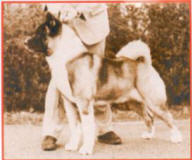 The male shown here proved himself as the ideal Akita, both in the ring and as the
#1 Sire of all Working breeds with 101 Champions and countless ROMPX progeny.
Ch. Okii Yubi Sachmo Of Makoto remained in the Top Five Breed and Group stats
for 5 consecutive years, owner handled, not campaigned but rarely ever defeated,
and at a time when an Akita was seldom considered at Group level. Sachmo
was and remains, a legend in the Akita breed. So what made him so great?
His charisma, dominance, assertiveness; his physical qualities and powerful
movement - but most of all, it was the daring and brilliance of judges who
recognized and awarded his impeccable TYPE.
The male shown here proved himself as the ideal Akita, both in the ring and as the
#1 Sire of all Working breeds with 101 Champions and countless ROMPX progeny.
Ch. Okii Yubi Sachmo Of Makoto remained in the Top Five Breed and Group stats
for 5 consecutive years, owner handled, not campaigned but rarely ever defeated,
and at a time when an Akita was seldom considered at Group level. Sachmo
was and remains, a legend in the Akita breed. So what made him so great?
His charisma, dominance, assertiveness; his physical qualities and powerful
movement - but most of all, it was the daring and brilliance of judges who
recognized and awarded his impeccable TYPE.
An Akita must have supreme agility, stability, and
balance when the quarry turns to fight. The Akita was a mighty hunter and
sorry, but he was a fighting breed. Note the level topline, proportion,
length of leg to body ratio, the deep strong body, where the brisket is, and the
perfect angles of a top-winning, top producing "plain fawn" Sachmo daughter.
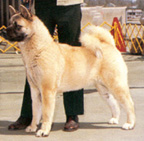 When
you see a “high in the rear” Akita let's hope it is a puppy, not an adult.
Straight stifles are no longer as common in the Akita but neither should you
award the over-angulated rears that are becoming popular among breeders.
The correct shoulder assembly can not balance an over-angulated rear and the
Akita dog becomes unsound for his purpose. As regards rear angulation,
think of it this way. If you placed a Doberman's back feet where they
belong (a plumb line from point of buttocks would touch the toes), he could not
have the incorrect rear angulation and sloping topline so fashionable today.
We must hope that the Akita breed doesn't drift from "moderate" to
over-angulated or lose his upstanding structure (and character) but then that is
up to you the judge because breeders will bring you what you most often award.
When
you see a “high in the rear” Akita let's hope it is a puppy, not an adult.
Straight stifles are no longer as common in the Akita but neither should you
award the over-angulated rears that are becoming popular among breeders.
The correct shoulder assembly can not balance an over-angulated rear and the
Akita dog becomes unsound for his purpose. As regards rear angulation,
think of it this way. If you placed a Doberman's back feet where they
belong (a plumb line from point of buttocks would touch the toes), he could not
have the incorrect rear angulation and sloping topline so fashionable today.
We must hope that the Akita breed doesn't drift from "moderate" to
over-angulated or lose his upstanding structure (and character) but then that is
up to you the judge because breeders will bring you what you most often award.
The Akita,
like many breeds, is in danger of becoming just another generic dog in profile
and personality, i.e. Americanized. Re-designing a breed is not up to the
judge. You can and should help improve a breed by guiding novice breeders
according to the AKC Breed Standard and the purpose of the breed. It
should never be about fashion or personal preference, particularly if your
background is in breeds such as the GSD or Irish Setter.
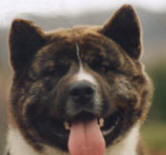
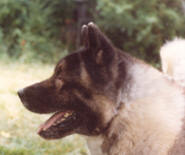 The Akita Head
The Akita Head
One of the most distinguishing features and rightfully
takes precedence in the Akita
Breed Standard containing 3 of the 5 disqualifications. The skull is
"flat between the ears," with powerful jaws capable of exerting enormous
pressure. In profile, the muzzle is shorter than the backskull and the
stop is "well defined but not too abrupt" as in the mastiff breeds.
The Akita shown in profile has excellent head proportion and stop.
None of
these ideal examples are "narrow or snipy." The Akita needs a
large, tight-lipped mouth with tremendous grip as in the Bull or Staffordshire
Terrier and for the same reason.
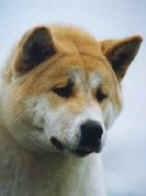 Note
the required "shallow furrow" extending from between the eyes well into the
backskull. You should not have to feel for it; the furrow should be clearly
visible. Dogs that lack furrow often have “ski-slope” stops, lack jaw
development, and the heads tend to be "narrow or snipy" and
overall, weak.
Note
the required "shallow furrow" extending from between the eyes well into the
backskull. You should not have to feel for it; the furrow should be clearly
visible. Dogs that lack furrow often have “ski-slope” stops, lack jaw
development, and the heads tend to be "narrow or snipy" and
overall, weak.
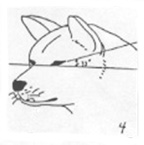 The
eyes are "small, deep set" (less likely to be injured in a fight) and "triangular".
They should not be too small! You don’t need to measure the ears. Ears
will be "small in relation to the rest of the head" but to measure
long ears against a long backskull, meaning a long way from the base of ear to
the eye rim, is a give-away that you read the standard but don’t understand the
breed. The drawing used in the Judges' Guide Book shows the correct eye
shape, size, and placement in relation to length of backskull and base of ears.
The
eyes are "small, deep set" (less likely to be injured in a fight) and "triangular".
They should not be too small! You don’t need to measure the ears. Ears
will be "small in relation to the rest of the head" but to measure
long ears against a long backskull, meaning a long way from the base of ear to
the eye rim, is a give-away that you read the standard but don’t understand the
breed. The drawing used in the Judges' Guide Book shows the correct eye
shape, size, and placement in relation to length of backskull and base of ears.
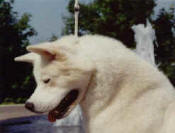 Think
chow-small ears in relation to the head and carried "slightly forward over
eyes in line with back of neck" as in this lovely white puppy with
perfect pigment. Akita ears are thick leathered, rounded on the tip, and wide
apart but not low set. They should be well furred - this is a northern
breed. The strength of the head, depth of muzzle, and mass of the skull,
should be awe-inspiring but never "wet" as in the mastiff breeds.
Think
chow-small ears in relation to the head and carried "slightly forward over
eyes in line with back of neck" as in this lovely white puppy with
perfect pigment. Akita ears are thick leathered, rounded on the tip, and wide
apart but not low set. They should be well furred - this is a northern
breed. The strength of the head, depth of muzzle, and mass of the skull,
should be awe-inspiring but never "wet" as in the mastiff breeds.
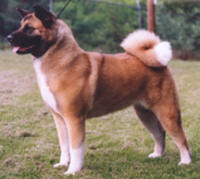 Bone and Substance
Bone and Substance
Demanded in both sexes. In World Of The
Akita, I characterized the female as an “iron hand in a velvet glove,” an oft-quoted term today. The red
female exemplifies that description. Straight in stifle, she is otherwise
impossible to fault. She excels in powerful body, well developed shoulder
and chest, thick muscular neck. Her strong head with forward-slanting ears
in line with her arched neck perfectly balance the required big, fat,
"bottle-brush" tail, fully curled, resting on a strong, level back. She
has bone, not legs full of chalk or back-brushed coat. Actually,
she has just discarded her summer coat preparing for a full off-standing winter
coat.
Neck and Body
Form
a unique and distinctive profile when looking at your lineup. The outline should be almost square in the male Akita, bitches only a
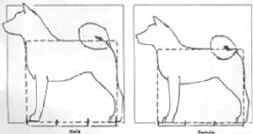 fraction
longer. There has been controversy about length of body but please, study this old drawing
which I included in the Judges Guide Book. The Akita, UNLIKE the Rottie,
is measured from the sternum, not the point of the shoulder. The back is
level and the leg-to-body ratio quite different than the Rottie which was a
draft dog. The Akita underline has moderate tuck up but he is not
“dumpy”. He should have plenty of daylight under him. There should be visible fore-chest indicating proper shoulder placement and ribcage.
fraction
longer. There has been controversy about length of body but please, study this old drawing
which I included in the Judges Guide Book. The Akita, UNLIKE the Rottie,
is measured from the sternum, not the point of the shoulder. The back is
level and the leg-to-body ratio quite different than the Rottie which was a
draft dog. The Akita underline has moderate tuck up but he is not
“dumpy”. He should have plenty of daylight under him. There should be visible fore-chest indicating proper shoulder placement and ribcage.
The thick neck flows into moderately laid back shoulders,
continuing on to a level topline, finished off by a generously coated "bottle
brush" high-set well curled tail that balances the big head.
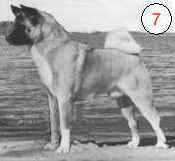 Study
the male Akita on the left. Ch. Jake finished novice owner-handled in a
total of three shows. He was never campaigned, which is a shame because he
was a shining example of a strong, masculine, perfectly proportioned Akita.
Note the massive head with ideal ear set, blending into a crested neck, perfect
shoulder and rear quarter – solid muscle and bone right down to his cat-feet.
Put a mental ruler on his proportion. This is an Akita in perfect balance,
perfect height to length body ratio balanced by a huge head and big
full-curl tail that rests on top of the back. “Big Jake” was 28 inches.
A tower of power, a gentle giant, and a classic example of the Akita.
Study
the male Akita on the left. Ch. Jake finished novice owner-handled in a
total of three shows. He was never campaigned, which is a shame because he
was a shining example of a strong, masculine, perfectly proportioned Akita.
Note the massive head with ideal ear set, blending into a crested neck, perfect
shoulder and rear quarter – solid muscle and bone right down to his cat-feet.
Put a mental ruler on his proportion. This is an Akita in perfect balance,
perfect height to length body ratio balanced by a huge head and big
full-curl tail that rests on top of the back. “Big Jake” was 28 inches.
A tower of power, a gentle giant, and a classic example of the Akita.
"Light bone, rangy body" is the only
serious fault in the
Akita
Standard. The brisket is deep, body powerful, with a short tight loin
because body length is in the rib cage. The stance is powerful, balanced
and capable of instant action propelled by a well-developed stifle, upper thigh,
and strongly defined hocks. Well developed tendons and muscle give the
mature dog a powerful, tight body with only moderate tuck-up. The legs should
not be extended rearward in order to set the hock perpendicular to the ground.
If the dog is stacked that way, there is too much rear angulation and he is "out
of balance" for both his utilitarian and his symbolic purpose.
You can feel the power in
that thick, muscular neck. Run your hands over the "well-sprung
ribs." (You noted the chest was wide and deep as you
approached the dog). Do not lean over the dog. Do not push him
around! You
will note that the Akita's skin is pliable, not loose but you probably
should not pinch him to determine that!
Akita Movement
Send ‘em around! Hopefully there were
several that caught your eye on the lineup.
Now you'll see if your first impression holds together. Akitas will tend
towards boredom as you begin individual examination but right now, the males are
mentally claiming turf on the go-around. Hopefully those that initially
filled your eye will not disappoint when moving.
The head
will not be held high, this is a serious dog that intends to get where he’s
going and to do it with the least amount of effort (don't forget that chow
ancestor.) A seasoned campaigner may not move with as much purpose as a
young dog that is still of the opinion he can take the lead away from the dog in
front. Even so, the Akita dog should move with power, determination,
moderate reach and drive, and solid topline. A dark “saddle” or large
marking on the mid-back may make the back appear to roll. In fact, if it
is fat as so many are shown, or it has loose skin, or if it is a gangly puppy,
the dog will roll. It is to be faulted.
BIS winner
Ch. Rambo demonstrates ideal movement. Note head carriage, solid topline,
big full tail, and moderate stride that still shows plenty of footpad. He
clearly shows that a short-coupled torso does not cause an Akita with proper
angulation to interfere or overreach.
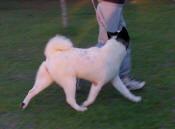 Movement is not the long floating strides of the GSD, nor the long ground covering
stride of many sporting or herding breeds. Indeed, the Akita's gait is "brisk"
as in stepping out at a faster pace. It is never choppy because the
topline remains firm and level if the back is short. "Strides of moderate
length" emphasizes two things. !.) it is not a long stride, and 2.) it
couldn't be if the Akita is short backed, close coupled and of moderate
angulation. The close-coupled "hooded" bitch is moving with
the correct reach and drive, hocks flexed but not over-extending or with too much kick behind.
Movement is not the long floating strides of the GSD, nor the long ground covering
stride of many sporting or herding breeds. Indeed, the Akita's gait is "brisk"
as in stepping out at a faster pace. It is never choppy because the
topline remains firm and level if the back is short. "Strides of moderate
length" emphasizes two things. !.) it is not a long stride, and 2.) it
couldn't be if the Akita is short backed, close coupled and of moderate
angulation. The close-coupled "hooded" bitch is moving with
the correct reach and drive, hocks flexed but not over-extending or with too much kick behind.
The Akita
standard assumes that we know the chest is "wide and deep" when it
states simply that "rear legs move in line with front legs." So
does the Akita single track? NO! Only if he lacks the well developed
chest with well sprung ribs, i.e. he has a narrow body, with a narrow center of
balance which would be pretty unhandy in a breed meant to do close combat.
Again, do not confuse this "hunter" with hounds, pointers or setters.
Examining The Akita
You may have been a bit disappointed when they went around, possibly you have
the class narrowed down already, but let’s be sure that all the parts are as they should be.
JUDGING TIP: Glen and Jean Fancy first assess
a dog from the profile stack position, then step to the front and approach
calmly, in a friendly, but non-excitable “hello doggy” manner. They stroke
(check) the head, quickly move on to the rest of the body, and then check teeth last after the dog has accepted the non-intrusive "petting" exam over the rear
quarters which includes checking testicles
while stroking the thigh or buttocks area. There is no need to engage in a
wrestling match or cause the dog to move out of a carefully arranged pose by
examining the bite first. This is great technique because even If you ask
the exhibitor to show the bite the dog invariably comes unstacked.
The bite can be level but scissors is preferred. Do not check molars. You don’t
count teeth in this breed so neither the handler or dog will be prepared for a full mouth exam.
The Akita Tail
So important that it has its
own section in the Akita Standard. It is "large and full."
That means strongly boned and well-coated, it should look like a fat bottle
brush. It must be long enough that it can curl. But as with
measuring ears, bear in mind that two wrongs don't make a right. A short
tail pulled down to to reach a long straight hock, well, it will. It has
to be "set high" in order to be "carried over the back."
Now here comes the part about which some judges have been (deliberately)
misled by folks that just couldn’t breed a tail to conform to the Akita
standard. That is their problem, it should not become yours!
 There
is only one thing to remember here. If it is looser than a full circle
(curl) it must be long enough to "drop well down the flank." Now
that makes it easy! Here's why. If only the tip touches the back it
can not be a full curl so it is to be disqualified. As depicted in the
Judges' Book, (illustration) it is an "uncurled" or "sickle tail" and either one
is a
disqualification. I have had judges say they attended a
seminar in which they were told “as long as it touches the back, it’s okay.”
It is not. The Akita Breed Standard says the tail must be a
"three-quarter, full, or double curl," and here's the key phrase, "always
dipping to or below level of back" but keep reading if you think just
“touching the back” is okay because the standard further explains: "a
three-quarter curl, tip drops well down flank."
There
is only one thing to remember here. If it is looser than a full circle
(curl) it must be long enough to "drop well down the flank." Now
that makes it easy! Here's why. If only the tip touches the back it
can not be a full curl so it is to be disqualified. As depicted in the
Judges' Book, (illustration) it is an "uncurled" or "sickle tail" and either one
is a
disqualification. I have had judges say they attended a
seminar in which they were told “as long as it touches the back, it’s okay.”
It is not. The Akita Breed Standard says the tail must be a
"three-quarter, full, or double curl," and here's the key phrase, "always
dipping to or below level of back" but keep reading if you think just
“touching the back” is okay because the standard further explains: "a
three-quarter curl, tip drops well down flank."
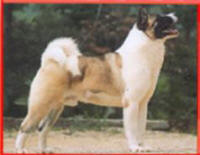 The
standard does not leave it up to interpretation. A full curl or a double
curl dips to or below the level of the back, but a looser three quarter curl
must drop well down the dog’s flank.
Only if it is a "full or double curl" can it just reach/touch the back.
There are only three acceptable tails. #1, A full curl, which is
NOT a partial curl or half circle. A full curl can rest on the back
(note is does not say "touch" the back) as in the white dog "Orca" and "Victor"
below. #2 A double curl, may also rest on the back as in BigSon
(left), a multi-group winner and All Time top sire . #3 A three-quarter
curl must drop well down the flank as in Jagger and Joker, both
multi-BIS Akitas shown below. Period. That's it. The
Akita tail is a unique breed feature, that's why there's no in-between. It
is a full curl (circle), a double curl, either of which may rest
on the back or on the side, or it can be a 3/4 (looser) curl
which, because it isn't coiled up, will be long enough to drop well down the
flank. Not just "touch" the back. Check this against the standard
(exact quotes) and then don't let anyone confuse you.
The
standard does not leave it up to interpretation. A full curl or a double
curl dips to or below the level of the back, but a looser three quarter curl
must drop well down the dog’s flank.
Only if it is a "full or double curl" can it just reach/touch the back.
There are only three acceptable tails. #1, A full curl, which is
NOT a partial curl or half circle. A full curl can rest on the back
(note is does not say "touch" the back) as in the white dog "Orca" and "Victor"
below. #2 A double curl, may also rest on the back as in BigSon
(left), a multi-group winner and All Time top sire . #3 A three-quarter
curl must drop well down the flank as in Jagger and Joker, both
multi-BIS Akitas shown below. Period. That's it. The
Akita tail is a unique breed feature, that's why there's no in-between. It
is a full curl (circle), a double curl, either of which may rest
on the back or on the side, or it can be a 3/4 (looser) curl
which, because it isn't coiled up, will be long enough to drop well down the
flank. Not just "touch" the back. Check this against the standard
(exact quotes) and then don't let anyone confuse you.
Forequarters and Hindquarters
Needs little explanation.
The Akita must have round, dense bone that does not break easily in a physical
confrontation. Fat is not muscle, nor is it substance. It is a cover up
for a dog that lacks both! The feet are important to a dog that must travel rough terrain without breaking down.
They are thick, cat feet, well knuckled up.
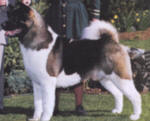 Akita Coat
Akita Coat
It's easy when you think about the Akita's developmental history. It gets cold
in the mountains of Japan. And an opponent should get only a mouthful of
double coat that stands off from the body. A thick
undercoat is protection from more than the elements and a big game hunter needs
something harder for a bear or boar to bite through. Two inches is
approximately the right length, but as long as the texture is right, a
longer coat is preferable to a shorter one which would fail to protect the dog.
Note I said texture because a soft coat will freeze up and offer little
protection.
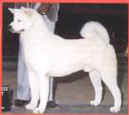 Color
Color
Simple - Any color. I mean how simple can it get?
We all have preferences and as a judge, you are entitled to have them too.
Some people love the flashy pintos, "which have large evenly placed patches
covering the head and more than one third of body;" some like brindle with
or without markings; some like whites, which "have no mask."
Am/Can. Ch Orca was the first white Akita to be campaigned.
He was #1 male, BB at WKC, and a multi-group winner as well as a top producer.
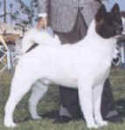 Many
people love the white bodied dogs we called “hooded” or by those who lack
experience in other breeds, “mismarked pinto.” Judges know that white dogs
in many breeds are head marked; Pyrs, Sealys, Bullies, etc etc. According
to the standard, it really doesn’t matter because if it didn’t say any color,
then red, black, or cream self- masked dogs would all be wrong! Ch. Joker
was the #1 Akita and a BIS winner but not everyone loved him. Those who claim to
be “purists” under the Japanese Standard are revolted by this color, (or any
color other than white-faced reds or brindles) but we judge the Akita under the
American Standard.
Many
people love the white bodied dogs we called “hooded” or by those who lack
experience in other breeds, “mismarked pinto.” Judges know that white dogs
in many breeds are head marked; Pyrs, Sealys, Bullies, etc etc. According
to the standard, it really doesn’t matter because if it didn’t say any color,
then red, black, or cream self- masked dogs would all be wrong! Ch. Joker
was the #1 Akita and a BIS winner but not everyone loved him. Those who claim to
be “purists” under the Japanese Standard are revolted by this color, (or any
color other than white-faced reds or brindles) but we judge the Akita under the
American Standard.
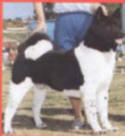 Some
people object to ticking or "freckles" but the Akita at left is an AKC BIS
winner and also a "Victor" in England where he vacationed for a while.
Colors are "brilliant and clear" and markings are well balanced.
Some argue that ticked or blotched white markings on Akitas are incorrect but
the standard makes no reference to ticking so it is personal opinion and has
little to do with the standard.
Some
people object to ticking or "freckles" but the Akita at left is an AKC BIS
winner and also a "Victor" in England where he vacationed for a while.
Colors are "brilliant and clear" and markings are well balanced.
Some argue that ticked or blotched white markings on Akitas are incorrect but
the standard makes no reference to ticking so it is personal opinion and has
little to do with the standard.
Ideal Size
It will always gets a good conversation
going. Some would say a 28" Akita is “too big” but this "large,
powerful" dog with "much substance and heavy bone" can carry more
than 28" and move properly if he's built right. I again refer you to the
B/W photo above. There is no upper limit but there is a
disqualification for too small, under 23" in bitches and under 25"
in the male. That clearly says size and strength is very important in the Akita.
Undersized
Akitas are to be disqualified. A popular BIS and Westminster winner was
measured out and Peggy Adamson disqualified another Best in Show winner from her
Group ring. Get a feel for size in both sexes. Better to avoid a
mistake that will come back to haunt you when a discerning judge measures.
The Akita is a large powerful dog so a reasonable person would understand that
too small is no small problem. Do not be afraid to measure.
Here are some tips to keep you and the dogs relaxed:
DO NOT make initial contact from the rear or side of the dog.
DO NOT grab an Akita by the head, cheeks, or foot.
DO NOT “bounce” the dog’s
topline, shoulders, or rear quarters or press down on his shoulders. (Dogs place
their heads or paw over another dog’s shoulder to test for dominance. A
mature Akita, male or female, will wonder whether to take you seriously or just
excuse your ignorance.)
DO NOT ever force
an exam on a shy or panicky Akita. If it is a puppy, pass him by and come
back later when the handler has him together. If it is an adult,
excuse the dog. If a second attempt fails, he is mentally unsound and in a
hundred pound dog, that is a problem. Use your “judgment” according to the
circumstances but do the breed a favor and get him out of the ring.
DO look for an almost square dog with the
small, distinctive ears tilted forward in line with the crested neck. The
massive head must be balanced by a large full curled tail.
You should
see courage and immense dignity and you will recognize that because knowing his
power, he will always be a gentleman. "He should be so confident of his
own superiority that he has no need to prove it.” That quote is
accurate. It is from my book and I think it sums up the character of an ideal Akita.
If you come away with nothing else today, I hope you will have gained insight into how to safely judge and accurately evaluate the Akita.
If you haven't read Judging Temperament & Character, do so now so that you don't take liberties that could result in embarrassment for you and the breed.
Reference {1}
Akita Breed Standard
TheJudgesPlace.com EST 2005 © 1998
http://www.thejudgesplace.com/Judging/Akitas/Head-to-Tail-bja-11998.asp
In memory of three of the Top 10 (owner handled) and Top 5 Akita Sires of all time:
Ch. Okii Yubi's Sachmo Of Makoto, Ch. O'BJ BigSon Of Sachmo, and Ch. The Widow-Maker O'BJ
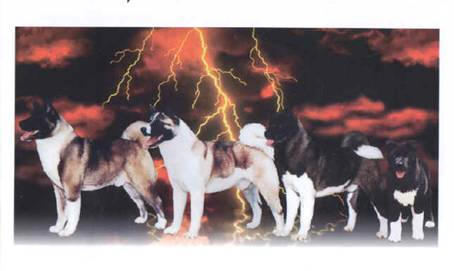
(photo work by Moretto Film Co . & ACE Akitas, Santiago, Chile, So. America - circa 1985)
MeetDog Show Judges - Ring Steward, Free & Share buttons, Visit Links
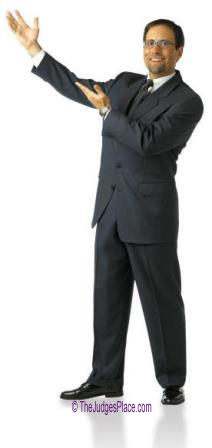
The Ring Steward says "Go back to the Judges Education Section!" We invite Judges to learn from more than a Seminar providing approved judging seminars with photographic examples of movement, structure, and breed type plus breed mentors to assist by email or phone. Courtesy NetPlaces Network, World's First Online Purebred Dog Information


Privacy Policy ~ Disclaimer ~ Web Contact
TheDogPlace.org, the world’s 1st public website, Animal Health to Vaccines.
The world's 1st online dog news, TheDogPress.com, AKC records to zoological news.
TheJudgesPlace.com, the world's 1st site by/for dog show judges, educates on purebred dogs.